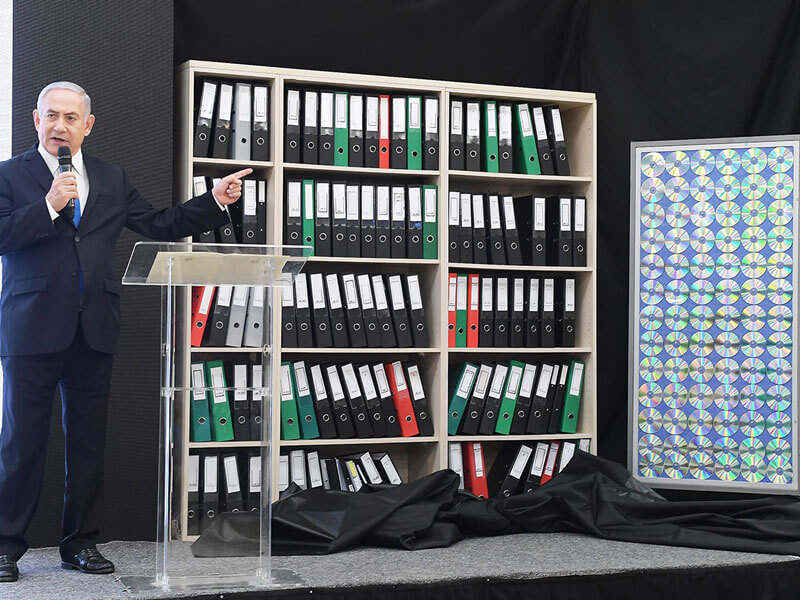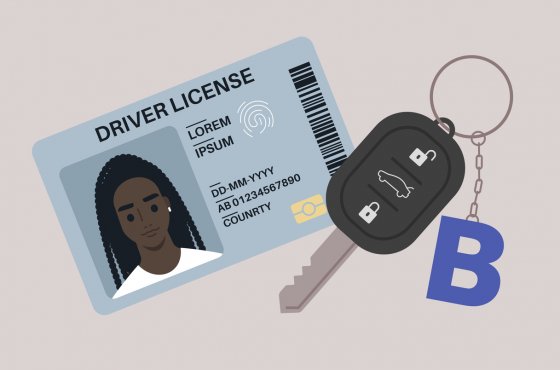After statements by Netanyahu, Trump confirmed the US readiness to withdraw from the nuclear deal with Iran: what he learned
On April 30, Israeli Prime Minister Benjamin Netanyahu unveiled documents showing, according to him, that Iran is violating the Vienna agreement providing for regular inspections of its nuclear facilities by IAEA experts in exchange for the lifting of Western sanctions.

Screenshot from video
US response
In response to this statement, US President Donald Trump announced the US readiness to withdraw from the nuclear deal with Iran.
“This situation is unacceptable. And I said this is happening. Iranians don't just sit back and do nothing. They launch rockets, they say, supposedly just for a spectacular television picture. But I do not think so. Let's see what happens, I can't say yet what I intend to do, we'll wait until May 12th. But that doesn't mean we won't reach a real deal," Trump said, adding that it was initially a "terrible deal" for the United States because America gave Iran more than $150 billion and got nothing in return.
In his opinion, the US withdrawal from the current nuclear agreement with Tehran will not create problems in negotiations with Kim Jong-un on the denuclearization of North Korea.
“I think leaving the deal would send the right signal to Pyongyang. You know that in seven years the deal with Iran will expire, and they will be able to continue to freely create nuclear weapons,” Trump said.
The reaction of Russia and Iran
Iran’s state television called Netanyahu’s “propaganda,” writes Newsru.
“There was nothing new in his words; they were full of baseless accusations. This is propaganda against everything Iran has done to resolve the nuclear weapons issue,” Iranian television said.
Iranian Deputy Foreign Minister for Political Affairs Abbas Arakchi suggested that the Israeli Prime Minister “gave a show” with which he wanted to influence the US position on the nuclear deal.
“The show Netanyahu put on was ridiculous and childish. This show is an attempt to influence Trump’s decision on the nuclear deal ahead of the May 12 deadline,” Araqchi said.
Russian President Vladimir Putin held a telephone conversation with Netanyahu, during which politicians discussed data released by Israel.
The Kremlin press service reported that Putin, in a conversation with Netanyahu, “confirmed Russia’s position.”
“The plan, which is of paramount importance for ensuring international stability and security, must be strictly observed by all parties,” the Russian leader said.
Meanwhile, EU High Representative for Foreign Affairs and Security Policy Federica Mogherini said that Benjamin Netanyahu’s words about Iran’s nuclear development do not prove that the country violated the provisions of the Joint Comprehensive Action Plan (SAPI).
“What I saw in Netanyahu’s statements did not call into question Iran’s compliance with its obligations under the JCPOA,” Mogherini said.
What Netanyahu said
The site Ministry of Foreign Affairs of Israel published the full text of the exposing speech of the Prime Minister of the country.

Israeli Prime Minister Benjamin Netanyahu presents the secret documents of the Iranian nuclear archive.
Photo: Ministry of Foreign Affairs of Israel
Tonight we will show you something that the world has never seen before. Tonight we will reveal a new and convincing proof of the existence of a secret nuclear weapons program, which Iran has hidden for many years from the international community in its secret atomic archive.
We are going to show you these secret nuclear archives of Iran.
You probably know that Iran’s leaders have repeatedly denied the suspicion that they are seeking nuclear weapons. You can listen to Iran’s supreme leader Ali Khamenei: "I emphasize that the Islamic Republic has never sought nuclear weapons." You can hear Iranian President Hassan Rouhani: “Nuclear weapons and other weapons of mass destruction do not have a place in the security concept of Iran and are contrary to our fundamental religious and ethical beliefs.” The same is repeated by Iranian Foreign Minister Javad Zarif: “We didn’t have any program to develop nuclear weapons. In any case, we view nuclear weapons as both irrational and immoral. ”
Tonight I'm here to tell you one thing: Iran lied. Lied big.
After the signing of the nuclear agreement in 2015, Iran intensified its efforts to conceal the secret archives of its nuclear program. In 2017, Iran has transferred this archive to one completely secret place in Tehran. This is the area of Shorabad in southern Tehran. Here they kept their atomic archives. Right here. Few Iranians knew where they were. Several Israelis knew about this.
From the outside, this building looked completely innocent - like an abandoned warehouse. However, inside it were Iran's massive secret atomic archives.
A few weeks ago, as a result of the great victory of our intelligence, Israel received half a ton of material hidden in these vaults. And that's what we got. Fifty five thousand pages. More 55 000 files on 183 CDs.
All you will see now is an exact copy of the original Iranian material.
You may ask - where are the originals? Well, I can say that they are in a very safe place now.
Here is what these files included: incriminating documents, incriminating graphics, incriminating presentations, incriminating drawings, incriminating photos, incriminating videos, and much more.
We shared this material with the United States, and the United States can vouch for its authenticity. We will also share it with other countries, and we will share it with the International Atomic Energy Agency.
So let me tell you the story of this material.
We have known for many years that Iran has a secret nuclear program called Project Amad. We can now prove that Project Amad is a comprehensive program to develop, build and test nuclear weapons. We can also prove that Iran is secretly storing project materials for use whenever the Tehran regime decides to develop nuclear weapons.
Here it is - the clear and frank goal of the Amad project: the creation of nuclear weapons. This is a genuine Iranian presentation, which sets out the main task: to design, manufacture and test five warheads, each of which should have a yield of 10 kilotons of TNT and be ready for installation on a missile. You don't need to read Farsi to understand this figure - 10 kilotons. This is the specific goal of the Amad project. These are five Hiroshima bombs prepared for ballistic missiles.
This is an authentic Iranian table from the archives of the Amad project. Yellow cake (uranium concentrate) production, centrifuge enrichment process, warhead design, modeling and testing project. And in fact, when we analyzed what was in these archives, we found that there were five elements to Project Amad, five key elements of the nuclear weapons program. I want to introduce them one by one.
The first element is the design of nuclear weapons. Here is an original Iranian illustration of a nuclear warhead. Again, you don't need to read Farsi to understand this. This U235 is enriched uranium, right here in the core. This is the only place where you find enriched uranium in the core of the ammunition. And here is the Iranian simulation, the original Iranian simulation, which combines all these components. This is the first element.
The second component is the development of the nuclear warheads themselves. Here is a photo showing the casting process and the cast metal core. And here is the secret underground facility that the Iranians were building to produce nuclear warheads. We have hundreds of documents on each of these components.
The third component is the creation of implosion systems for detonating a nuclear warhead. This is an original Iranian photograph of a measuring device for such a system. And here is a simulation of an implosive explosion.
The fourth component is preparation of nuclear tests. Here's a map of five potential nuclear test sites in eastern Iran. We have many such documents.
And finally, the fifth component is the integration of nuclear weapons and missile delivery vehicles. Here is the design of the “nuclear payload” for the Shihab-3 rocket. Here is the warhead, here is the bomb itself. And I don't need to remind you that Iran is constantly expanding the range of its nuclear-capable ballistic missiles. They started with 1000 kilometers, now they have reached about 2000. They can fly to Riyadh, Tel Aviv, Moscow, but the Iranians do not stop there and are working on much longer distances. They plan to use much longer-range missiles to deliver nuclear weapons.
These documents convincingly prove that Iran is brazenly lying when it claims that it has never had a nuclear weapons program.
Here's what happened next. In 2003, Iran faced increasing external pressure. You will remember that this happened after the Gulf War. Iran was therefore forced to shelve the Amad project, but it did not give up its nuclear ambitions. Iran has developed a new two-pronged plan - first, to preserve the knowledge and experience accumulated during nuclear development under Project Amad and, second, to continue developing its nuclear weapons-related capabilities. This plan was developed directly by Iran's top leadership.
There is another document in the archive. In accordance with the new directive of Iranian Defense Minister Ali Shamkhani (today he is the secretary of the Iranian National Security Council), work on the project will be divided into two parts, covert and open. A key part of the plan was the creation of new organizations to continue this work, as defined by Dr. Mohsen Fakhrizadeh, director of the Amad project. Remember this name - Fakhrizadeh. So here's his directive, right here. She says, “The overall goal is to announce the closure of Project Amad,” but then he adds:
"Special events" - you know what they are - "special events will be held under the name of scientific development of technological methods." That's exactly what Iran did. The Iranian regime continued this work through a number of organizations over the ensuing years, and today, in 2018, it continues under a structure called SPND (Organization for Defense Innovation and Research) within the Iranian Ministry of Defense. And you won't be surprised to learn that SPND is led by the same person who led Project Amad - Dr. Fakhrizadeh. It is also no coincidence that many key SPND employees worked under Fakhrizadeh's leadership on the Amad project.
Thus, this atomic archive clearly shows that Iran was planning - at the highest level - to continue nuclear weapons-related work under different covers, using the same personnel.
I want to give another example of Iran's nuclear weapons development activities that continued after Project Amad. Do you remember Fordo? Fordo Uranium Enrichment Complex? This was a secret underground processing facility that the Iranians built under the mountain. Of course, you wouldn't hide thousands of centrifuges to produce medical isotopes like that. You will do this for one reason and one reason only: they are designed to create nuclear weapons. These documents indicate that Fordo was originally designed and built for precisely this purpose as part of Project Amad.
Here is Fordo's real Iranian plan. Iran continued to build Fordo in secret, years after Project Amad ended. It will hardly surprise you that Iran insisted on keeping Fordo. Incredible, but true - Iran achieved this as part of the nuclear deal.
Iran retained Fordo, but on one condition. As part of the nuclear deal, Iran was required to provide the International Atomic Energy Agency (IAEA) with all information about its nuclear program. This condition was necessary for the completion of the nuclear deal. Iran had to “repent.” In December 2015, the IAEA did publish its final assessment of what the agency called the "military aspects" of Iran's nuclear program. This was Iran's chance to make a full confession to the IAEA.
They could have told the truth. They could say "we had this program, this secret program, it's over, we put it aside, it doesn't exist, we destroyed its material." But this is what Iran actually said to the IAEA. He stated that "Iran denies the existence of a coordinated program aimed at developing a nuclear explosive device." In particular, Iran denied the existence of the Amad project. These documents prove that Iran authorized, initiated and financed Project Amad, a coordinated program aimed at developing a nuclear explosive device.
Here is another document from the archive. This is the master plan for the Amad project. Iran told the IAEA that it did not carry out any work on “multipoint initiation” - MPI. You'll have to forgive me—this jargon, this scientific terminology, is essential to understanding nuclear weapons production. So, the Iranians say that no work has been done with MPI technology in hemispherical geometry. The archive again shows that Iran is lying. Iran has done extensive work with MPI technology in hemispherical geometry. Here's one example. This is confirmed by hundreds of other documents.
Iran told the IAEA that it did not carry out metallurgical work specifically designed for a nuclear device. The archive again shows that Iran is lying. Iran has carried out extensive metallurgical works specifically aimed at the needs of the nuclear device. Here is the original Iranian photograph, there are many more in the archive.
What I showed you this evening is just a fraction of the total amount of material that we have. But even from these examples, you can draw four main conclusions. First, Iran lied about never having a nuclear weapons program. 100 secret documents prove they lied. Second, even after the deal, Iran continued to maintain and expand its technological knowledge of nuclear weapons for future use. Why does a terrorist regime hide and carefully sort its secret nuclear archives, if not for the purpose of later use? Third, Iran lied again in 000 when it did not confess to the IAEA, as required by the terms of the nuclear deal. And finally, the Iran deal, the nuclear deal, is based on lies. It is based on Iranian lies and Iranian deception. 2015 of these documents directly prove that they lied.
So here's the bottom line. Iran continues to lie. Just last week Zarif said this: “We never wanted to produce a bomb.” Once again: “We never wanted to make a bomb.”
Yes you wanted. Yes, you tried. And the atomic archive proves it.
The nuclear deal gives Iran an open path to the nuclear arsenal because it provides the Tehran regime with the three components necessary to create this arsenal. First, unlimited enrichment in a few years. Iranians are planning exactly that. They plan to launch several hundred thousand centrifuges of the new generation, with the help of which they will be able to enrich the mountains of uranium to create the warhead that I showed you before, and many, many more such warheads. Secondly, it absolutely does not affect the ongoing Iranian development of ballistic missiles. And thirdly, and this is news, it absolutely did not cope with the task of giving an answer to the secret Iranian program of creating an atomic bomb and turning it into an ammunition ready for use. We just did it. This agreement allows Iran to have a whole arsenal of nuclear bombs and makes it possible to get billions of dollars to finance its aggression against Israel and other countries in the Middle East.
By revealing these documents, Israel does important work. We are doing important work not only for our security, but also for the security of other countries in the region.
A few days later, President Trump will announce his decision on a nuclear deal with Iran. I am sure that he will make the right decision. The right decision for the United States, the right decision for Israel, the right decision for global security.
The essence of the transaction
The Joint Comprehensive Action Plan (SAPA), signed by Iran, the five permanent members of the UN Security Council (Russia, UK, China, USA, France) and Germany in July 2015, aims to resolve the crisis around Tehran’s nuclear development. In response to the lifting of the sanctions previously imposed on Iran by the UN Security Council, the United States and the European Union, Tehran has pledged to limit its nuclear activities and put it under international control. The agreement entered the implementation phase in January 2016..
Trump has repeatedly criticized this deal, arguing that it did not prevent Iran from developing nuclear weapons, but only delayed the day when Tehran would have nuclear warheads.
The Iran Nuclear Review Act requires the president to certify to Congress every 90 days that Tehran is complying with its commitments. Trump has already criticized Iran several times for violating the terms of the deal, but did not lift the freeze on sanctions against this country. The next date for “certification” of the transaction is May 12.
Read also on ForumDaily:
9 high-risk countries for Americans
How to escape in the event of a nuclear war
How world leaders call each other
Subscribe to ForumDaily on Google NewsDo you want more important and interesting news about life in the USA and immigration to America? — support us donate! Also subscribe to our page Facebook. Select the “Priority in display” option and read us first. Also, don't forget to subscribe to our РєР ° РЅР ° Р »РІ Telegram and Instagram- there is a lot of interesting things there. And join thousands of readers ForumDaily New York — there you will find a lot of interesting and positive information about life in the metropolis.











